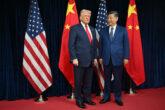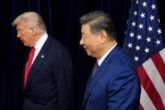January 01, 2018
US Alliances and Trump’s ‘Free and Open Indo-Pacific’ Policy
Any single year’s events can mask the true direction of longer-term trends. Time will tell, but I believe this is the case with respect to US policy toward the Asia-Pacific region during 2017. Undeniably, the year has seen momentum swings, nuclear danger and heightened uncertainty. But for all the disruption, the fundamental US commitment to regional allies is steadfast. Further, President Donald Trump’s November trip to Asia shows that he intends to build on the agenda of his predecessor by forging new and stronger partnerships in pursuit of a free and open Indo-Pacific region.
Five Geopolitical Challenges
The world is beset with grave international security challenges. Despite this trend — indeed, because of it — alliances are rising in value. Resurgent major-power competition, combined with upstart regional actors and persistent transnational terrorism, create the impression that America’s relative military and economic power is in rapid decline. Although I would argue that perceptions can deceive (America remains strong), the salient point is that the US cannot and need not face these challenges alone. Fortunately, it possesses something no other power or group can claim: an extensive array of capable, committed allies and partners with a variety of overlapping interests and values. The Trump administration is acutely aware of this fact, even as it presses allies into sharing risks and burdens hitherto unknown.
Before turning to the alliances in Asia, it is worthwhile considering the major challenges that US foreign policy faces globally: a fragmenting rules-based order; the rise of Asia (including, but not limited to, China’s re-emergence as a great power); new questions relating to the reliability of the US; mounting global challenges; and problems of governance that spill over into neighboring states and regions.
Read the full commentary in Global Asia.
More from CNAS
-
Chinese Maker of Bitcoin-Mining Machines Is a Security Threat, Says Expert
Bloomberg News reports that a Chinese manufacturer, Bitmain Technologies Ltd, that sells most of the world’s Bitcoin-mining machines — including 16,000 of them to a venture ba...
By David Feith
-
Indo-Pacific Security / Energy, Economics & Security
North Korea’s Provocations, Power Plays, and Shifting AlliancesTensions on the Korean Peninsula have reached a new and dangerous threshold. President Lee Jae Myung is warning of a real risk of accidental military clashes, as the situation...
By Dr. Go Myong-Hyun
-
Indo-Pacific Security / Energy, Economics & Security
How to Win the Economic War with ChinaTrump's approach to China has run aground, giving Beijing unprecedented advantage in the economic conflict....
By Edward Fishman & Julian Gewirtz
-
Indo-Pacific Security / Technology & National Security
Sharper: Tech + ChinaRecent talks between President Donald Trump and Chinese Communist Party General Secretary Xi Jinping placed a spotlight on emerging technologies, from high-end chips to minera...
By Charles Horn & Sevi Silvia




